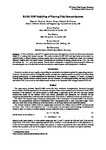RANS-VOF Modelling of Floating Tidal Stream Systems
| dc.contributor.author | Ransley, E | |
| dc.contributor.author | Brown, Scott Andrew | |
| dc.contributor.author | Greaves, Deborah | |
| dc.contributor.author | Hindley, S | |
| dc.contributor.author | Weston, P | |
| dc.contributor.author | Guerrini, E | |
| dc.contributor.author | Starzmann, R | |
| dc.date.accessioned | 2019-04-04T09:34:46Z | |
| dc.date.available | 2019-04-04T09:34:46Z | |
| dc.date.issued | 2016-03-21 | |
| dc.identifier.uri | http://hdl.handle.net/10026.1/13615 | |
| dc.description.abstract |
A fully nonlinear coupled CFD approach has been developed to simulate the behaviour and power output of a floating tidal stream concept. The model includes RANS-VOF and rigid body solvers based on OpenFOAM®, a hybrid-catenary mooring system and a two-way-coupled, actuator-line model for a Schottel Instream Turbine with over-speed control. Simulations are performed in spring currents at the PTEC site with and without the 1-in-1 year wave present. Results show considerable complexities beyond periodic behaviour necessitating the use of models that include the complete coupled system and hydrodynamic conditions. Introduction Numerical models are now capable of providing the quantitative description required for engineering analysis. However, for structures such as floating tidal stream concepts, the complete system can rarely be included using existing functionality. To better understand the behaviour of these systems, a coupled CFD model, including a floating barge, hybrid-catenary mooring system and the influence of a submerged turbine, has been developed and tested at full-scale in waves and currents based on those at the Perpetuus Tidal Energy Centre (PTEC) site. | |
| dc.language.iso | en | |
| dc.title | RANS-VOF Modelling of Floating Tidal Stream Systems | |
| dc.type | conference | |
| plymouth.date-start | 2016-03-21 | |
| plymouth.date-finish | 2016-03-22 | |
| plymouth.conference-name | in Proceedings of the 5th Oxford Tidal Energy Workshop | |
| plymouth.organisational-group | /Plymouth | |
| plymouth.organisational-group | /Plymouth/Faculty of Science and Engineering | |
| plymouth.organisational-group | /Plymouth/Faculty of Science and Engineering/School of Engineering, Computing and Mathematics | |
| plymouth.organisational-group | /Plymouth/PRIMaRE Publications | |
| plymouth.organisational-group | /Plymouth/REF 2021 Researchers by UoA | |
| plymouth.organisational-group | /Plymouth/REF 2021 Researchers by UoA/UoA12 Engineering | |
| plymouth.organisational-group | /Plymouth/Research Groups | |
| plymouth.organisational-group | /Plymouth/Research Groups/Marine Institute | |
| plymouth.organisational-group | /Plymouth/Users by role | |
| plymouth.organisational-group | /Plymouth/Users by role/Academics | |
| plymouth.organisational-group | /Plymouth/Users by role/Researchers in ResearchFish submission | |
| dc.publisher.place | Oxford, UK | |
| dcterms.dateAccepted | 2016-03-21 | |
| dc.rights.embargoperiod | Not known | |
| rioxxterms.licenseref.uri | http://www.rioxx.net/licenses/all-rights-reserved | |
| rioxxterms.licenseref.startdate | 2016-03-21 | |
| rioxxterms.type | Conference Paper/Proceeding/Abstract |


